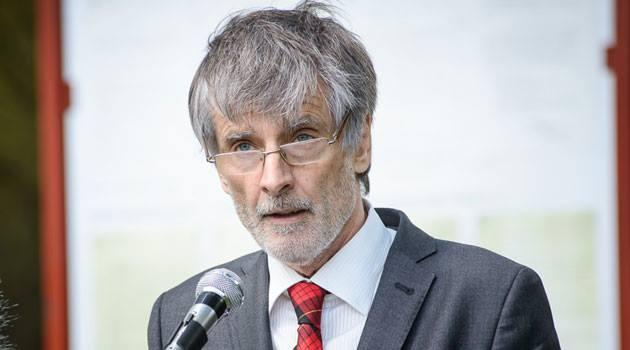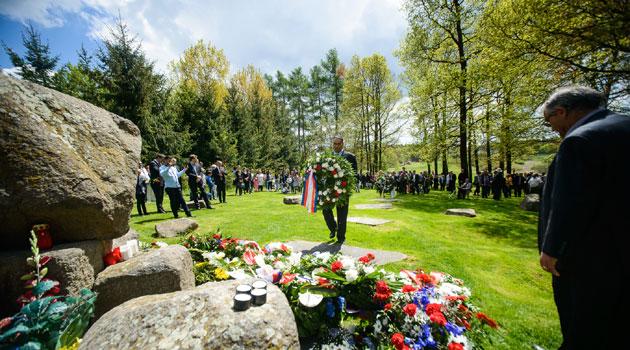Slovak Ambassador at Romani genocide commemoration: Honoring the memory of victims of racial hatred is important for all countries

Peter Weiss, the Slovak Ambassador to the Czech Republic, attended the traditional commemorative ceremony honoring the memory of the Romani victims of the Holocaust at Lety which was held this year on Saturday, 13 May. On this occasion he gave a speech in which he summarized the important historical events that accompanied the victims’ persecution at the time.
The ambassador mentioned the importance of bearing in mind that with a a population of 12 million people, the Roma and Sinti represent the European Union’s biggest minority group. He ended his speech with the motto “Ma Bisteren – Never Forget”; news server Romea.cz publishes in English translation his full speech below.
Speech by Slovak Ambassador Peter Weiss at the Lety Memorial, 13 May 2017
Esteemed Mr Růžička, esteemed members of the Czech Government and Parliament, fellow ambassadors, dear Czech friends,
The place we have assembled here today at this memorial to the criminal treatment of Romani people at the so-called labor camp at Lety, from which 420 Romani prisoners were transported to their deaths at Auschwitz, and in which almost the same number of prisoners, including children, perished as a consequence of the inhumane conditions, is not of significance to the Czech Republic alone. For all of us who have gathered here from different states, this memorial is a symbolic reminder of where politics based on racial hatred can lead, politics based on the arrogant imagining that some groups are inferior and that the nation or race assuming itself to be superior has the right to humiliate the allegedly inferior group, to disregard them, to deprive them of their civil and human rights, to abuse them, and to kill or methodically annihilate them – in other words, to perpetrate genocide. This memorial to the victims of the camp at Lety, which as of 1942 was called a “gypsy” camp, reminds us that the targeted enemies of the “racially pure state”, which Hitler’s so-called Third Reich and its satellite states wanted to be, were, along with the Jews, the Roma and Sinti.
In Nazi Germany and its occupied territories, as well as in the satellite states of the so-called Third Reich, the Roma and Sinti were afflicted by the same persecution and policies that culminated in the attempt to absolutely annihilate them as a group. Jewish people have a metaphoric name for this genocidal policy, the Shoah, or the catastrophe, and the Roma have the term Porajmos, which means the devouring.
Let’s recall that the fate, first of just the Roma in Germany, was decided by the Nuremberg Laws of 1935. Roma and Romani “half-breeds” were labelled inferior by those laws. Roma who were married to citizens of the Reich were categorized as “superior”. They got the chance to survive, but not to have children of their own, as their sterilization was ordered. After German troops occupied a big portion of Europe, the clouds bgan to gather over the Romani populatoin of the occupied countries. In the autumn of 1942, SS head Heinrich Himmler said it was “high time for the asocial elements to be destroyed through labor”. The labor camps began to arise, which became waystations on the journey to the concentration camps where prisoners were annihilated.
Since the Romani community in Central and Eastern Europe was not as organized as other communities, and because its history has been transmitted primarily orally, through stories, the Porajmos remained insufficiently documented for a long time. The number of Romani victims of the Holocaust in Europe has not yet managed to be ascertained with absolute reliability. Historians, however, agree that it has long been underestimated. The more recent literature mentions data of half a million or more Romani victims.
For various reasons, the Porajmos was, until recently, also spoken of as the unknown Holocaust. The same applies to the tragedy of the Slovak Roma. “The Roma Holocaust is usually called unrecognized because neither the general public, nor Romani people themselves, nor scholars know much about the events that happened in connection with the Second World War and the position of Romani people,” Slovak ethnographer Zuzana Kumanovo wrote one year ago. The author Branislav Oláh has said that “The stories of Romani people have been forgotten due to the lack of interest on the part of both majority-society experts and the lay public, as well as the bad experiences of the Romani people who survived the Second World War. While the Roma did attempt to see justice done, they encountered the fact that the culprits were never punished and that their own stories were minimized or directly labelled as falsehoods.” Romani people preferred to remain silent about this history, and they did not want to trautmatize their children with stories about the war. One Slovak Romani woman who was forced to the concentration camps, Helena Dömeová of Nové Zámky, when remembering how she was pushed onto a train carriage and sent to Dachau, said: “I do not want to speak my children about it, because they wouldn’t believe it. Whomever I tell about it does not want to believe how much we suffered.” The director of the Romani Studies Institute, Jozef Ravasz, said this unpleasant truth in 2013: “The topic of the Romani Holocaust has been a taboo for many long years, and not just in Slovakia, and it has been distorted, and many facts about the annihilation of this minority by the Fascists and the Nazis during the Second World War are still unknown to the majority population, and unfortunately to many Romani people also.”
For that reason, it is good for not just academics and NGOs to take a more intensive interest in this aspect of our history in Slovakia, but also that our politicians do so. Gradually, a societal discussion has developed describing the ethnic dimension of the suffering of Romani people during the war. In 2005 the Museum of the Slovak National Uprising unveiled the first of a series of memorials called “Ma Bisteren! – Never Forget!” in the Remembrance Hall there. The memorial and the date of 2 August are meant to point out to the public that Romani people were subjected during the Second World War to ethnic persecution and racially-motivated violence. Since 2005, several Romani NGOs have begun to fill in the historical gaps in the matter of the Romani Holocaust. As part of the “Ma Bisteren!” project they have gradually unveiled memorials in Lutila, Německá, Hanušovce nad Topľou, Zvolen, v Slatina and Dubnice nad Váhom. The civic association “Romano jilo” has unveiled a memorial at Čet and József Ravasz has initiated the building of a memorial at Dunajská Streda. The first Slovak Prime Minister to pay homage to the memory of 60 Romani people who were executed by Hungarian Nazis just before the end of the Second World War in that town was Róbert Fico. (In 1992 in Czechoslovakia, together with myself and another three MPs on the Slovak National Council, Mr Fico was the co-author of a bill to make the day of the Slovak National Uprising a state holiday in the Czech Republic and the basis of our own state tradition).
Later, in 2001, convinced that it was necessary to further commemorate Holocaust victims as part of grappling with all displays of hatred, intolerance, racism, xenophobia and any form of discrimination and oppression in the Slovak Republic, Mr Fico pushed through in the Slovak Parliament a new remembrance day, 9 September, which is now the Day of the Victims of the Holocaust and Racial Violence. He took up the motion made by Slovak President Rudolf Schuster, who advocated introducing this memorial day. President Schuster had promised during an official visit to Israel in February 2000 to advocate for the adoption of such a law. That memorial day is a sad reminder of the adoption of the Jewish Code by the Government of the Slovak State on 9 September 1941. That legislation, 270 paragraphs long, summarized the anti-Jewish and anti-Romani decrees that had already been adopted and expanded them. Inspiration for the legislation may have been drawn from the Nazi Nuremberg Laws, but it was the representatives of the wartime Slovak State who declared their own citizens to be inferior and who exposed them to being deported to concentration camps, discriminated against and persecuted.
We in Slovakia must never forget this. It is all the more important because the ultra-right has now made it into the Slovak Parliament, as it has in other European states. The Slovak ultra-right right openly admires the policies and regime of the wartime Slovak State and President Jozef Tiso, declaring him a martyr. We are justified in considering them Fascist. Precisely for that reason, it is necessary not just to build memorials to the Romani victims of the Holocaust everywhere that Romani people were murdered in Slovakia, but to visit them. Commemorating these crimes and what preceded them is one instrument we have for preventing the radicalization of society.
We must never forget the decree issued in 1940 by the Interior Ministry which defined Romani people as “asocial” persons, as that became the basis of their persecution. We must never forget the military law, issued in that same year, that banned Jews and Roma from joining the miliary. We must never forget the wartime decree according to which Romani people had to remove their homes from the local roads and move several kilometers beyond the territorial limits of municipalities, which caused relationships between the majority society and the Romani population that had been maintained for generations to break down. We must never forget the establishment of the so-called labor units for “asocials”, a term that was understood to mean primarily Romani people. In the labor units at Ilava, Dubnice nad Váhom, Ptičie and in the area of Hanušoviec nad Topľou, hundreds of Romani people suffered forced imprisonment and hard labor under terrible conditions.
We must never forget the deportations of Romani people from the territory of Slovakia to the concentration camp at Dachau, territory which, after the Viennese arbitrage, was annexed by Horthy’s Hungary. During the war, 25 000 Romani people were deported from Hungary to the concentration camps, and what proportion of them were from Slovak territory is unknown.
Finally, we must never forget that many Romani people actively joined the Slovak National Uprising. Some of their communities were situated near the forest and therefore created a link between the partisans and the villages. After the uprising was suppressed, Romani communities were charged with aiding Partisans and some of their settlements were set on fire and erased from regional maps. Lutila, Čierny Balog, Dúbravy, Ilija, Detva, Německá, Zvolen, Kremnička are all places where mass murder happened at that time.
Esteemed friends, we should all, in our own countries, remember the suffering of the people who became the victims of racial hatred and violence. Let’s remember that 12 million Romani and Sinti people are the biggest minority in the European Union. Allow me to close my speech here with the motto of the Slovak project that is focused on acknowledging the Roma Holocaust – “Ma Bisteren – Never Forget”.
Thank you for patiently listening to me.
